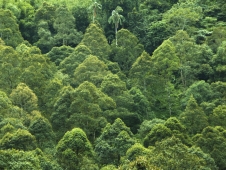
BirdLife International has created the Forests of Hope programme to bring together and build on its successful forest conservation and management programmes throughout the tropics. BirdLife Partners have been working in tropical forest conservation for decades, in more than 50 countries. The Forests of Hope programme aims to identify and pilot innovative management, financing and governance systems for forest and biodiversity conservation and restoration, generating local and national economic benefits for sustainable development, and combating climate change.
Tropical forests are the most ecologically rich of all forest types. Three quarters of all bird species are found in forests, chiefly in the tropics; the majority, especially threatened species, are dependent on intact habitat for their survival. Tropical forests are also of great value for their contribution to climate change mitigation through carbon storage and sequestration. Global and local communities also depend on tropical forests for the provision of other ecosystem services (e.g., water provision, forest-products, recreation and tourism).
Unfortunately, however, despite their recognised importance, tropical deforestation has not been halted and in fact continues at a frightening rate, equivalent in area to around one football pitch every 4 seconds, or more than 7 million hectares per year. Furthermore, tropical deforestation has serious impacts on the world’s climate. Globally, deforestation and forest degradation account for 15–20% of all human induced carbon emissions, and a large proportion of this takes place in the tropics. This is therefore one of the major causes of global warming.
BirdLife’s Forests of Hope Programme is working in tropical countries around the world to pilot innovative management, financing and governance systems for forest and biodiversity conservation and restoration. The programme’s effectiveness is maximised by linking forest conservation on the ground to policy and advocacy work at national and international levels.
The programme’s principal objectives are:
The four main programme activities include:
The Forest of Hope Programme is underpinned by BirdLife’s sound scientific research through identification of forest species that are closest to extinction, the most significant sites for bird conservation (Important Bird Areas) and the most important areas of forest for forest-dependent birds.
These efforts help to underpin the selection of Forests of Hope, alongside practical considerations and local capacity. For more information about this Global Programme and individual Forests of Hope project sites click here.
Related Case Studies in other sections
Compiled: 2012 Copyright: 2012
Recommended Citation:
BirdLife International (2012)
BirdLife’s Forests of Hope programme will protect five million hectares of tropical forest.
Downloaded from https://datazone.birdlife.org/birdlife’s-forests-of-hope-programme-will-protect-five-million-hectares-of-tropical-forest on 23/12/2024